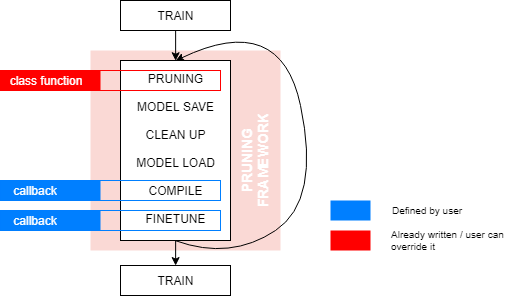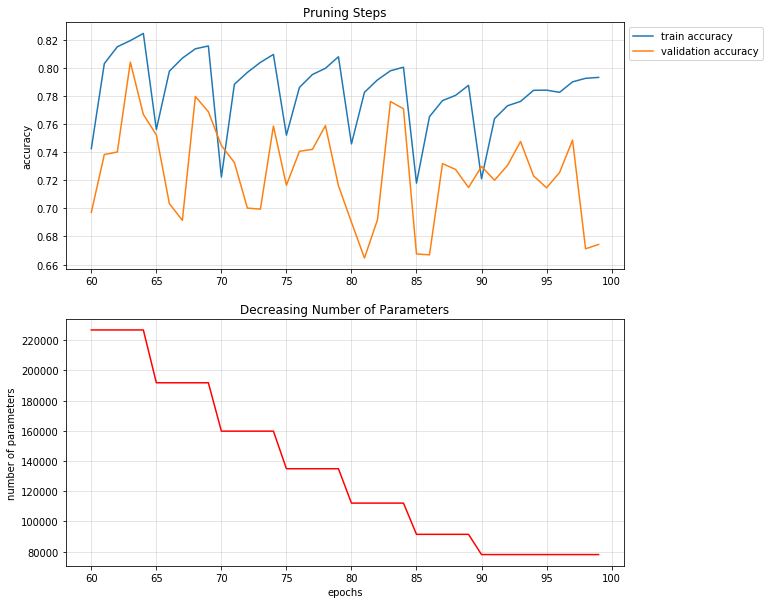gaborvecsei / Ridurre Network Filter Pruning Keras
Programming Languages
Projects that are alternatives of or similar to Ridurre Network Filter Pruning Keras
Ridurre - Filter Pruning in Deep Convolutional Networks
Pruning is the process when we try to shrink a network by removing the not so significant/redundant filters.
This package is a mini-framework which you can easily use on your existing models and also you can define your own pruning methods without any struggle.

Install
pip install ridurre
- Install packages inside
requirements.txtpip install -r requirements.txt
Example Results
These results were achieved with the example provided:
- Cifar10 dataset
- ResNetV1
- KMeans filter pruning
- Clustering factor:
0.9(which can be considered as an aggressive pruning)
- Clustering factor:


Usage
Define you own pruning method
You can make your own pruning method by creating a new class which has the parent BasePruning. There is only 1 thing
you should take care and that the implementation of the run_pruning_for_conv2d_layer function.
For an example just take a look at the RandomFilterPruning code.
Use an already existing method
Check out the example/model_pruning_example.py for a simple but
extensive tutorial
Callbacks
You will need to define 2 callbacks for the pruning:
-
Model compile function
- 1 argument:
-
modelwhich is akeras.models.Model
-
- This should define how to compile the model
- Example:
def compile_model(my_model): my_model.compile(optimizer=optimizers.Adam(lr=0.001), loss=losses.categorical_crossentropy, metrics=["accuracy"])
- 1 argument:
-
Finetune function
- 3 arguments:
-
modelwhich is akeras.models.Model -
initial_epochwhich is anint: This defines the initial epoch state for the model fitting. For example it is 12 if we trained the model for 12 epochs before this function was called -
finetune_epochswhich is anint: Defines how much should we train after a pruning.
-
- This should define how to finetune out model
- Example:
def finetune_model(my_model, initial_epoch, finetune_epochs): my_model.fit(x_train, y_train, 32, epochs=finetune_epochs, validation_data=(x_test, y_test), callbacks=callbacks, initial_epoch=initial_epoch, verbose=1)
- 3 arguments:
Pruning
You will need to select which pruning method you would like to use. In this example I will use the KMeans pruning
import ridurre
# Create the model
model = build_model(...)
# Define compile callback
def compile_my_model(model):
model.compile(...)
# Compile with your callback (of course you can use different compilation for this train and the pruning)
compile_my_model(model)
# Train if you would like to start from a better position
model.fit(...)
# Define finetuning callback
def finetune_my_model(model, initial_epoch, finetune_epochs):
model.fit(..., epochs=finetune_epochs, initial_epoch=initial_epoch)
# We can start pruning
pruning = ridurre.KMeansFilterPruning(0.9,
compile_my_model,
finetune_my_model,
6,
maximum_pruning_percent=0.4,
maximum_prune_iterations=12)
model, _ = pruning.run_pruning(model)
At the end of the pruning step, you will have a trained and pruned model which you can use. I can recommend to train your model after the pruning for just a little longer as an extra step towards accuracy.
Future work
- Look for problematic cases, where there is a merging (like
add) and warn the user that the different inputs to that operations should be pruned in the same manner- A good example for a case like this is ResNet
- Define "pruneable" set of layers
- With regex or layer indices
- This needs to find
add,multiply,average, etc... operations (layers) which needs same filter number from the different inputs
- Different pruning factors for channels with different number of filters
- More pruning solutions
- Do not depend on kerassurgeon as I only use the channel delete function
Papers
[1] Filter Level Pruning Based on Similar Feature Extraction for Convolutional Neural Networks
[2] Demystifying Neural Network Filter Pruning
About
Gábor Vecsei
